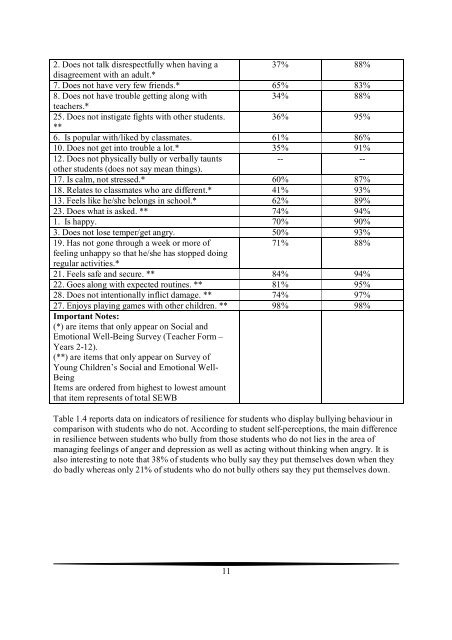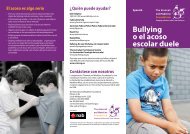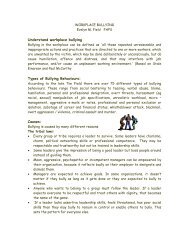The social and emotional wellbeing of students who bully different ...
The social and emotional wellbeing of students who bully different ...
The social and emotional wellbeing of students who bully different ...
You also want an ePaper? Increase the reach of your titles
YUMPU automatically turns print PDFs into web optimized ePapers that Google loves.
2. Does not talk disrespectfully when having a37% 88%disagreement with an adult.*7. Does not have very few friends.* 65% 83%8. Does not have trouble getting along with34% 88%teachers.*25. Does not instigate fights with other <strong>students</strong>.36% 95%**6. Is popular with/liked by classmates. 61% 86%10. Does not get into trouble a lot.* 35% 91%12. Does not physically <strong>bully</strong> or verbally taunts-- --other <strong>students</strong> (does not say mean things).17. Is calm, not stressed.* 60% 87%18. Relates to classmates <strong>who</strong> are <strong>different</strong>.* 41% 93%13. Feels like he/she belongs in school.* 62% 89%23. Does what is asked. ** 74% 94%1. Is happy. 70% 90%3. Does not lose temper/get angry. 50% 93%19. Has not gone through a week or more <strong>of</strong>71% 88%feeling unhappy so that he/she has stopped doingregular activities.*21. Feels safe <strong>and</strong> secure. ** 84% 94%22. Goes along with expected routines. ** 81% 95%28. Does not intentionally inflict damage. ** 74% 97%27. Enjoys playing games with other children. ** 98% 98%Important Notes:(*) are items that only appear on Social <strong>and</strong>Emotional Well-Being Survey (Teacher Form –Years 2-12).(**) are items that only appear on Survey <strong>of</strong>Young Children’s Social <strong>and</strong> Emotional Well-BeingItems are ordered from highest to lowest amountthat item represents <strong>of</strong> total SEWBTable 1.4 reports data on indicators <strong>of</strong> resilience for <strong>students</strong> <strong>who</strong> display <strong>bully</strong>ing behaviour incomparison with <strong>students</strong> <strong>who</strong> do not. According to student self-perceptions, the main differencein resilience between <strong>students</strong> <strong>who</strong> <strong>bully</strong> from those <strong>students</strong> <strong>who</strong> do not lies in the area <strong>of</strong>managing feelings <strong>of</strong> anger <strong>and</strong> depression as well as acting without thinking when angry. It isalso interesting to note that 38% <strong>of</strong> <strong>students</strong> <strong>who</strong> <strong>bully</strong> say they put themselves down when theydo badly whereas only 21% <strong>of</strong> <strong>students</strong> <strong>who</strong> do not <strong>bully</strong> others say they put themselves down.11









